MITSUBISHI ECLIPSE 1990 Service Manual
Manufacturer: MITSUBISHI, Model Year: 1990, Model line: ECLIPSE, Model: MITSUBISHI ECLIPSE 1990Pages: 391, PDF Size: 15.27 MB
Page 241 of 391
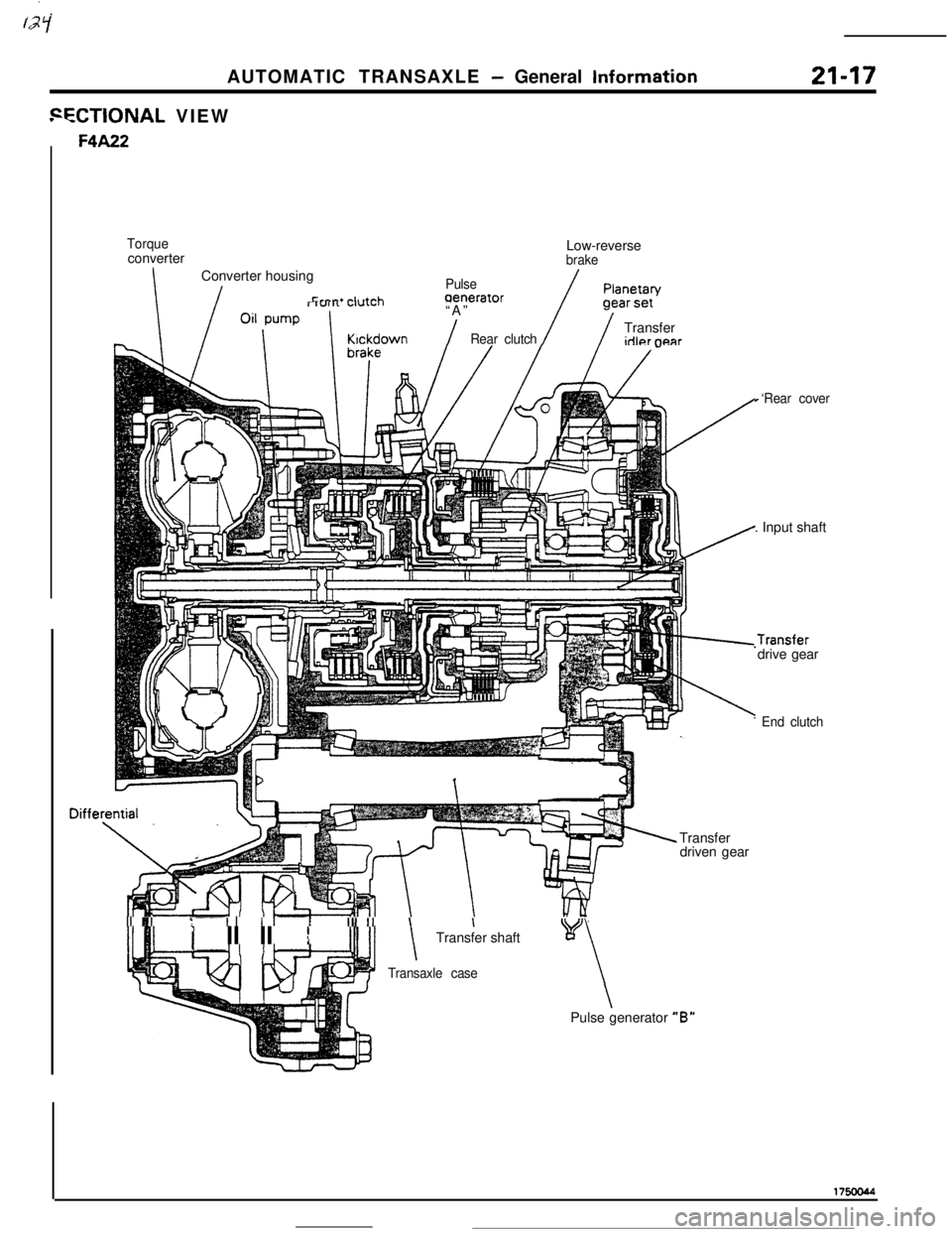
AUTOMATIC TRANSAXLE - General Information21-17
FECTIONAL VIEW
TorqueLow-reverse
converter
brake
IConverter housingIPulse/Planetan/t.mw.+ 4, .+rb-xaeneratormm-r .-Pa+*i, pump rlulll LI”LbII“A”$JGcll JCL
IIKlckdownIRear clutch/ /Transferifilnr mar
I‘Rear cover. Input shaft.Transfer
drive gear
’ End clutchTransfer
driven gear
II
81:-I IIIBII \IKx!J\
II II
f\Transfer shaftK
Transaxle case\
\Pulse generator “B”
Page 242 of 391
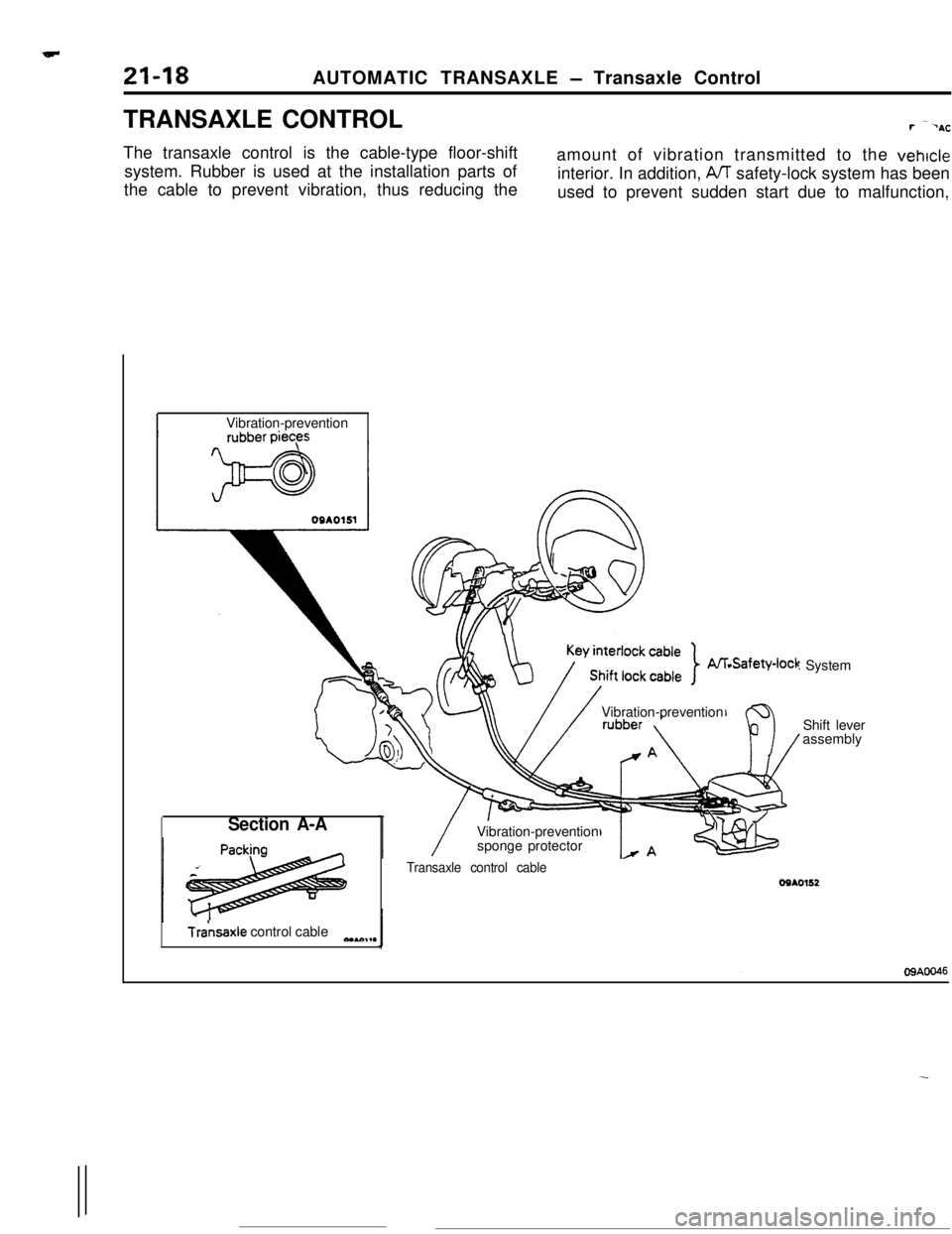
21-18AUTOMATIC TRANSAXLE - Transaxle Control
TRANSAXLE CONTROLr---AC
The transaxle control is the cable-type floor-shift
system. Rubber is used at the installation parts of
the cable to prevent vibration, thus reducing theamount of vibration transmitted to the
vehicleinterior. In addition,
A/T safety-lock system has been
used to prevent sudden start due to malfunction,
Vibration-prevention
Vibration-prevention
Vibration-prevention
sponge protector
Section A-A
Tra’nsaxle control cableeaAc.,,*
: System
Shift lever
assembly
Transaxle control cableOSAO152
Page 243 of 391
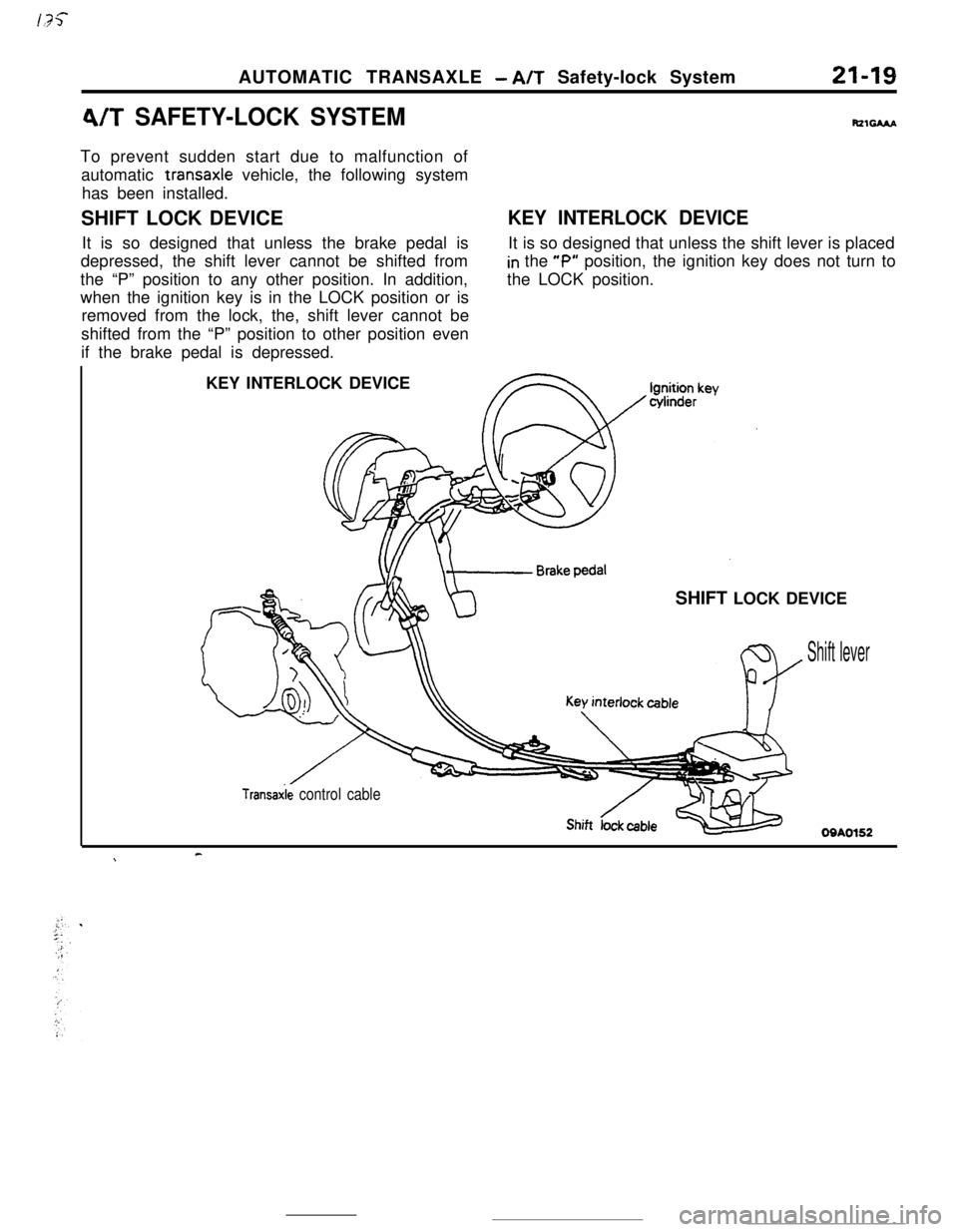
AUTOMATIC TRANSAXLE - A/T Safety-lock System21-19
4/T SAFETY-LOCK SYSTEMRzsAAaTo prevent sudden start due to malfunction of
automatic transaxle vehicle, the following system
has been installed.
SHIFT LOCK DEVICE
It is so designed that unless the brake pedal is
depressed, the shift lever cannot be shifted from
the “P” position to any other position. In addition,
when the ignition key is in the LOCK position or is
removed from the lock, the, shift lever cannot be
shifted from the “P” position to other position even
if the brake pedal is depressed.
KEY INTERLOCK DEVICEIt is so designed that unless the shift lever is placed
in the “P” position, the ignition key does not turn to
the LOCK position.
KEY INTERLOCK DEVICE
SHIFT LOCK DEVICE
Shift lever
Transaxie control cable
Shift dieOQA0152
c\
Page 244 of 391
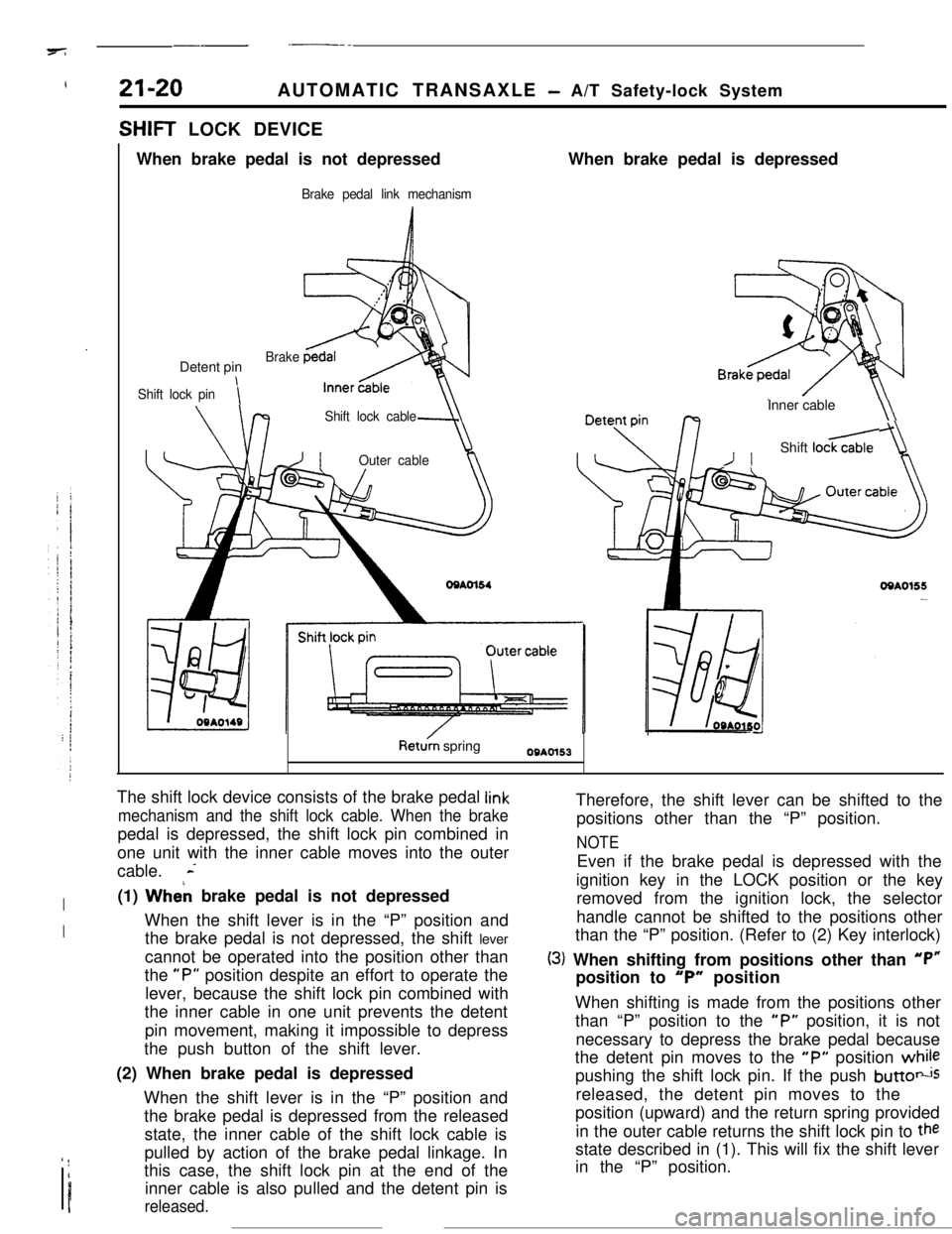
-_ - .--.7
!21-20AUTOMATIC TRANSAXLE - A/T Safety-lock System
SHIFT LOCK DEVICE
When brake pedal is not depressed
Brake pedal link mechanismWhen brake pedal is depressed
Detent pin
Shift lock pini
Brake
Shift lock cable
-JIOuter cableInner cable
\\
/IShift loc&
OQAO155-
Ret& springOBAOl53
The shift lock device consists of the brake pedal
link
mechanism and the shift lock cable. When the brakepedal is depressed, the shift lock pin combined in
one unit with the inner cable moves into the outer
cable.
L
I(1) Wheh brake pedal is not depressed
IWhen the shift lever is in the “P” position and
the brake pedal is not depressed, the shift lever
cannot be operated into the position other than
the
“P” position despite an effort to operate the
lever, because the shift lock pin combined with
the inner cable in one unit prevents the detent
pin movement, making it impossible to depress
the push button of the shift lever.
(2) When brake pedal is depressed
When the shift lever is in the “P” position and
the brake pedal is depressed from the released
state, the inner cable of the shift lock cable is
’ !I
Ipulled by action of the brake pedal linkage. In
this case, the shift lock pin at the end of the
inner cable is also pulled and the detent pin isreleased.Therefore, the shift lever can be shifted to the
positions other than the “P” position.
NOTEEven if the brake pedal is depressed with the
ignition key in the LOCK position or the key
removed from the ignition lock, the selector
handle cannot be shifted to the positions other
than the “P” position. (Refer to (2) Key interlock)
(3) When shifting from positions other than “P”position to
“P” position
When shifting is made from the positions other
than “P” position to the
“P” position, it is not
necessary to depress the brake pedal because
the detent pin moves to the
“P” position whilepushing the shift lock pin. If the push
buttotisreleased, the detent pin moves to the
position (upward) and the return spring provided
in the outer cable returns the shift lock pin to
thestate described in (1). This will fix the shift lever
in the “P” position.
Page 245 of 391
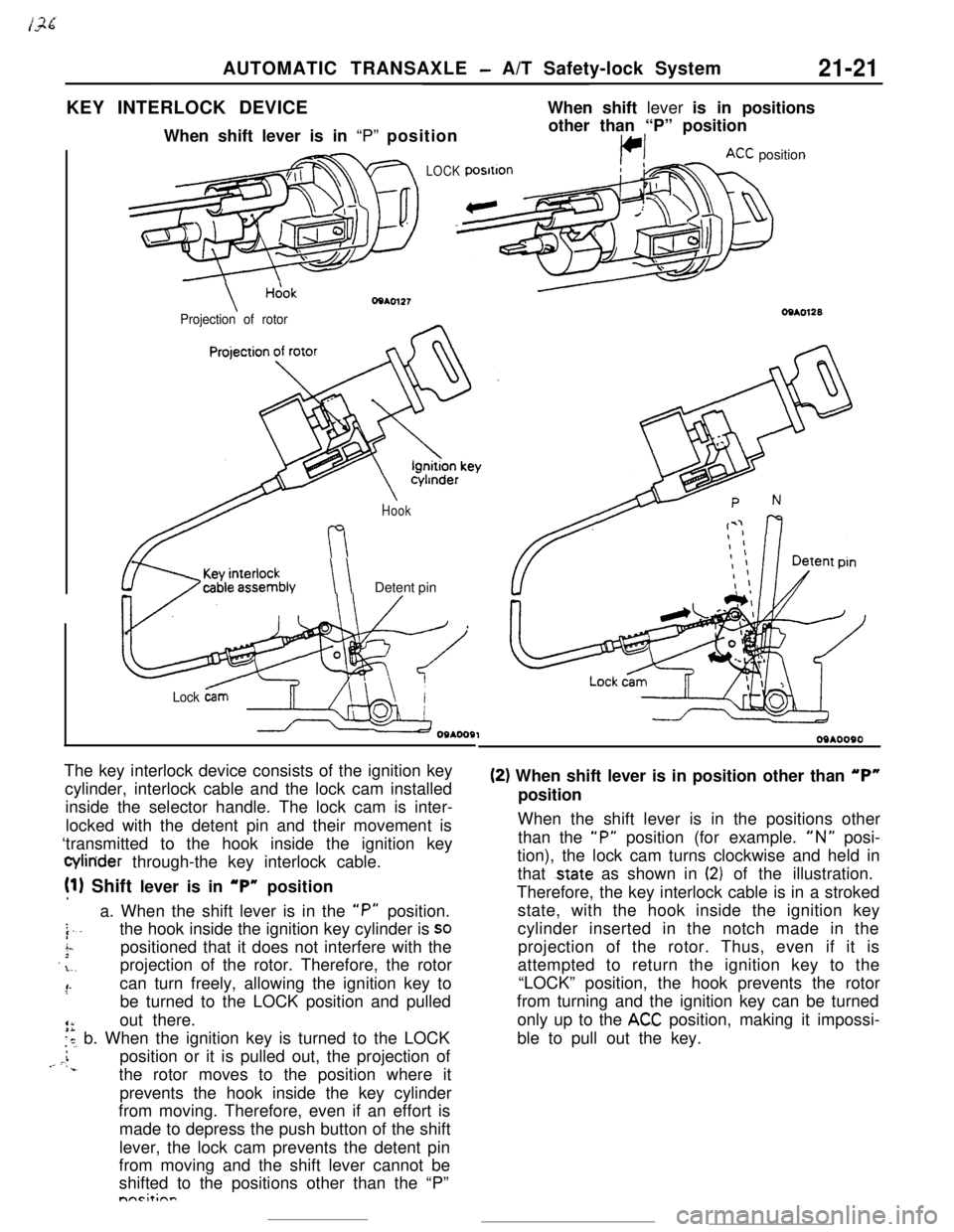
AUTOMATIC TRANSAXLE - A/T Safety-lock System21-21KEY INTERLOCK DEVICEWhen shift lever is in positions
When shift lever is in “P” position
LOCK
\Hcjok
Projection of rotorother than “P” position
KC position
Hook
\ \Detent pin
Lock &mThe key interlock device consists of the ignition key
cylinder, interlock cable and the lock cam installed
inside the selector handle. The lock cam is inter-
locked with the detent pin and their movement is
‘transmitted to the hook inside the ignition key
Q4inder through-the key interlock cable.
!l) Shift lever is in “P” position
a. When the shift lever is in the
“P” position.
j..the hook inside the ignition key cylinder is SO
i-.3positioned that it does not interfere with the’ .L.,projection of the rotor. Therefore, the rotor
:‘-can turn freely, allowing the ignition key to
be turned to the LOCK position and pulled
out there.
is, b. When the ignition key is turned to the LOCK
i,- c.position or it is pulled out, the projection of‘..the rotor moves to the position where it
prevents the hook inside the key cylinder
from moving. Therefore, even if an effort is
made to depress the push button of the shift
lever, the lock cam prevents the detent pin
from moving and the shift lever cannot be
shifted to the positions other than the “P”nnrit;nn
09*0090
(2) When shift lever is in position other than “P”position
When the shift lever is in the positions other
than the
“P” position (for example. “N” posi-
tion), the lock cam turns clockwise and held in
that
.state as shown in (2) of the illustration.
Therefore, the key interlock cable is in a stroked
state, with the hook inside the ignition key
cylinder inserted in the notch made in the
projection of the rotor. Thus, even if it is
attempted to return the ignition key to the
“LOCK” position, the hook prevents the rotor
from turning and the ignition key can be turned
only up to the
ACC position, making it impossi-
ble to pull out the key.
Page 246 of 391
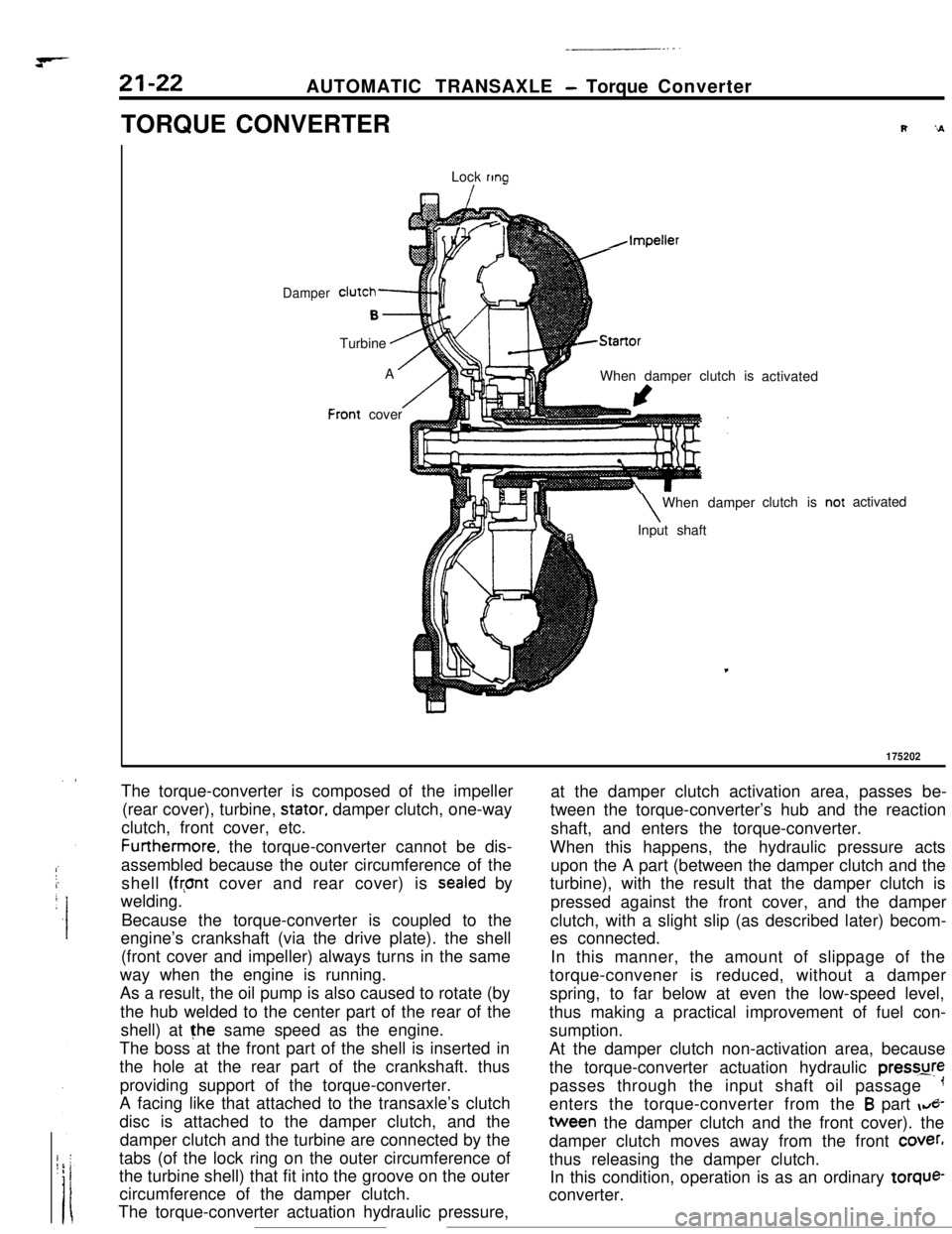
AUTOMATIC TRANSAXLE - Torque Converter
TORQUE CONVERTER
Lock
ring
I
Damper
F
clutch-
B-.Turbine
.AA
/:ront cover
h,Impeller
AStartorWhen damper clutch is
I\When damper
aInput shaftactivated
clutch isactivated
175202The torque-converter is composed of the impeller
(rear cover), turbine,
stator, damper clutch, one-way
clutch, front cover, etc.Furthermore. the torque-converter cannot be dis-
assembled because the outer circumference of the
shell
(front cover and rear cover) is sealed by
welding.
Because the torque-converter is coupled to the
engine’s crankshaft (via the drive plate). the shell
(front cover and impeller) always turns in the same
way when the engine is running.
As a result, the oil pump is also caused to rotate (by
the hub welded to the center part of the rear of the
shell) at the same speed as the engine.
The boss at the front part of the shell is inserted in
the hole at the rear part of the crankshaft. thus
providing support of the torque-converter.
A facing like that attached to the transaxle’s clutch
disc is attached to the damper clutch, and the
damper clutch and the turbine are connected by the
tabs (of the lock ring on the outer circumference of
the turbine shell) that fit into the groove on the outer
circumference of the damper clutch.
The torque-converter actuation hydraulic pressure,at the damper clutch activation area, passes be-
tween the torque-converter’s hub and the reaction
shaft, and enters the torque-converter.
When this happens, the hydraulic pressure acts
upon the A part (between the damper clutch and the
turbine), with the result that the damper clutch is
pressed against the front cover, and the damper
clutch, with a slight slip (as described later) becom-
es connected.
In this manner, the amount of slippage of the
torque-convener is reduced, without a damper
spring, to far below at even the low-speed level,
thus making a practical improvement of fuel con-
sumption.
At the damper clutch non-activation area, because
the torque-converter actuation hydraulic pressure
passes through the input shaft oil passage
-1enters the torque-converter from the
B part &-tween the damper clutch and the front cover). the
damper clutch moves away from the front
cover,thus releasing the damper clutch.
In this condition, operation is as an ordinary torque-
converter.
Page 247 of 391
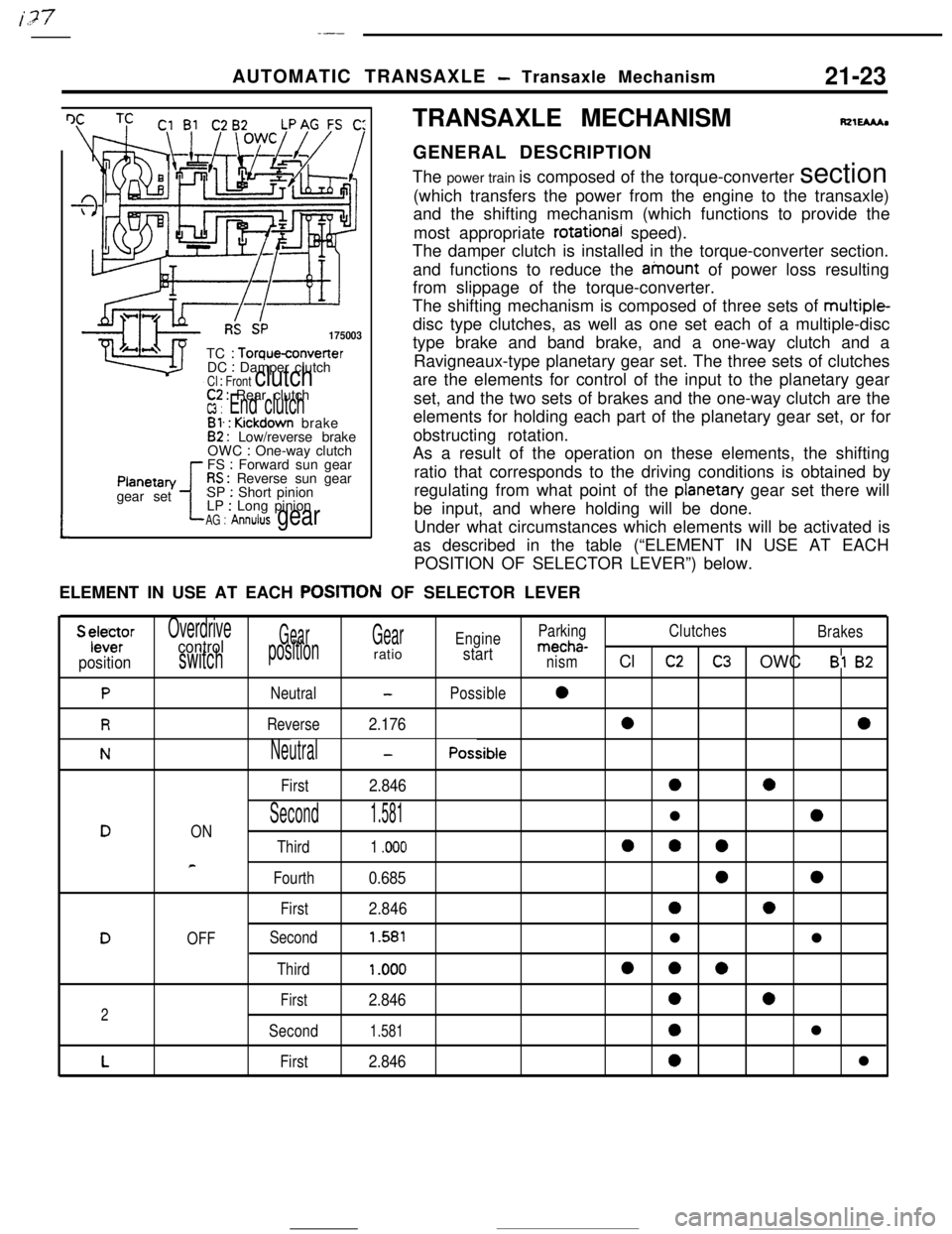
I,?+7_-AUTOMATIC TRANSAXLE
- Transaxle Mechanism21-23
I IRS SP175003TC
: Torqueconverter
DC : Damper clutchCl : Front clutch
tPlanetan/
gear set
C2 : Rear clutchW : End clutchBl. : Kickdown brake82 : Low/reverse brake
OWC : One-way clutch
FS : Forward sun gearRS : Reverse sun gear
SP : Short pinion
LP : Long pinionAG : Annulus gearTRANSAXLE MECHANISM
fQlEMhGENERAL DESCRIPTION
The power train is composed of the torque-converter section
(which transfers the power from the engine to the transaxle)
and the shifting mechanism (which functions to provide the
most appropriate
rotational speed).
The damper clutch is installed in the torque-converter section.
and functions to reduce the ainount of power loss resulting
from slippage of the torque-converter.
The shifting mechanism is composed of three sets of multiple-
disc type clutches, as well as one set each of a multiple-disc
type brake and band brake, and a one-way clutch and a
Ravigneaux-type planetary gear set. The three sets of clutches
are the elements for control of the input to the planetary gear
set, and the two sets of brakes and the one-way clutch are the
elements for holding each part of the planetary gear set, or for
obstructing rotation.
As a result of the operation on these elements, the shifting
ratio that corresponds to the driving conditions is obtained by
regulating from what point of the
planetan/ gear set there will
be input, and where holding will be done.
Under what circumstances which elements will be activated is
as described in the table (“ELEMENT IN USE AT EACH
POSITION OF SELECTOR LEVER”) below.
ELEMENT IN USE AT EACH
POSITtON OF SELECTOR LEVER
S ylele~rOverdriveGearGearEngineParkingClutches
Brakescontrolmecha-
positionswitchpositionratiostartnismCl c2C3 OWC Bl 82
PNeutral-Possible0
RReverse2.17600
NNeutral-Possible
First
2.8460a
Second1.581l0DON
Third1 .ooo000
e
Fourth0.68500
First2.84600
DOFFSecond1.581ll
Third1 .ooo000
First2.846002
Second1.5810l
LFirst2.8460l
Page 248 of 391
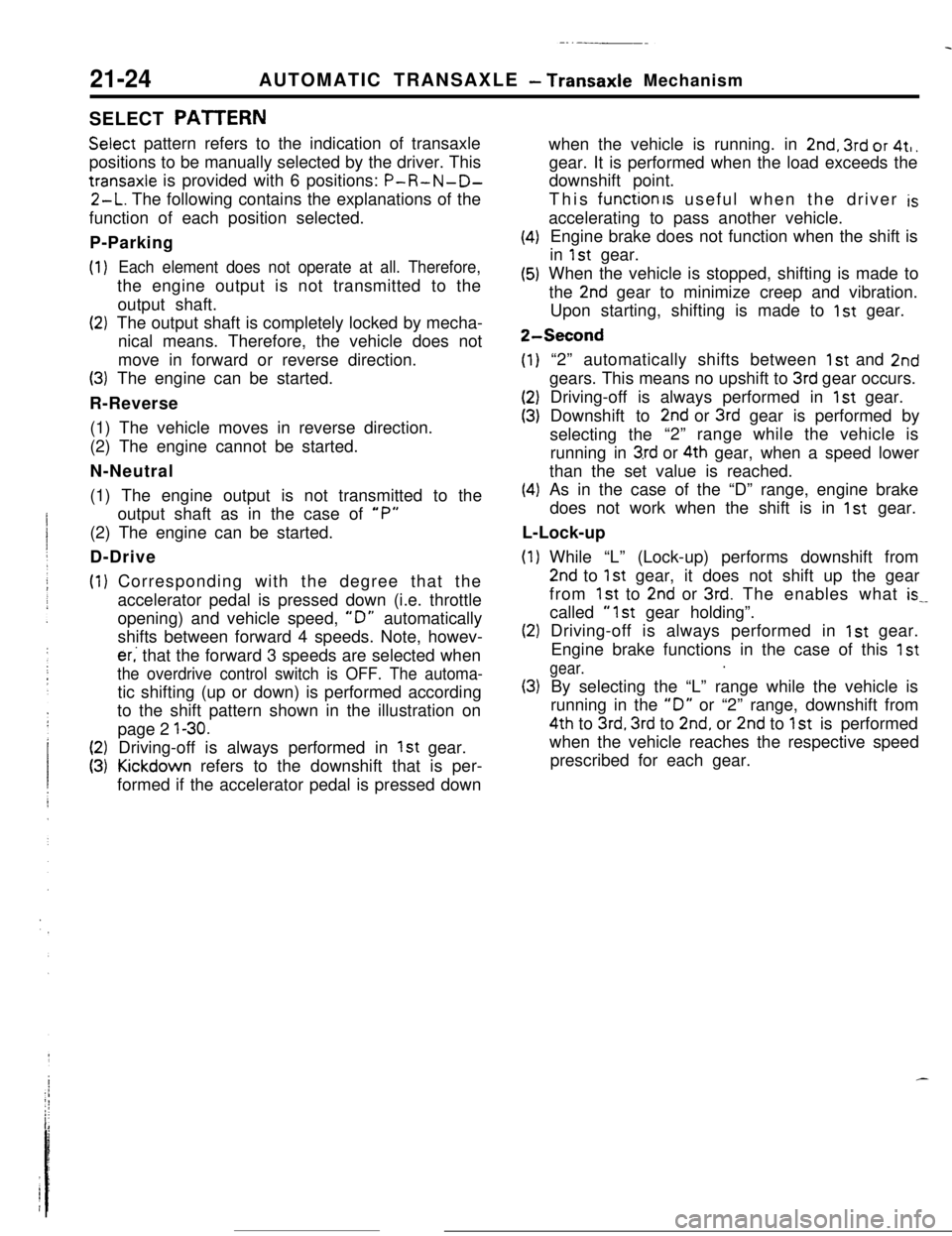
21-24AUTOMATIC TRANSAXLE - Transaxle Mechanism
SELECT PATTERN
Select pattern refers to the indication of transaxle
positions to be manually selected by the driver. This
transaxie is provided with 6 positions: P-R-N-D-
2-L. The following contains the explanations of the
function of each position selected.
P-Parking
(1)
(2)
(3)
Each element does not operate at all. Therefore,the engine output is not transmitted to the
output shaft.
The output shaft is completely locked by mecha-
nical means. Therefore, the vehicle does not
move in forward or reverse direction.
The engine can be started.
R-Reverse
(1) The vehicle moves in reverse direction.
(2) The engine cannot be started.
N-Neutral
(1) The engine output is not transmitted to the
output shaft as in the case of
“P”(2) The engine can be started.
D-Drive
(1)
(2)
(3)Corresponding with the degree that the
accelerator pedal is pressed down (i.e. throttle
opening) and vehicle speed,
“D” automatically
shifts between forward 4 speeds. Note, howev-
er,’ that the forward 3 speeds are selected when
the overdrive control switch is OFF. The automa-tic shifting (up or down) is performed according
to the shift pattern shown in the illustration on
page 2
l-30.Driving-off is always performed in
1st gear.Kickdown refers to the downshift that is per-
formed if the accelerator pedal is pressed down
(4)
(5)when the vehicle is running. in
2nd. 3rd or 4t,.
gear. It is performed when the load exceeds the
downshift point.
This function
IS useful when the driver isaccelerating to pass another vehicle.
Engine brake does not function when the shift is
in
1st gear.
When the vehicle is stopped, shifting is made to
the
2nd gear to minimize creep and vibration.
Upon starting, shifting is made to
1st gear.
S-Second
(1)
(2)
(3)“2” automatically shifts between
1st and 2ndgears. This means no upshift to
3rd gear occurs.
Driving-off is always performed in
1st gear.
Downshift to
2nd or 3rd gear is performed by
selecting the“2” range while the vehicle is
running in
3,rd or 4th gear, when a speed lower
than the set value is reached.
(4)As in the case of the “D” range, engine brake
does not work when the shift is in
1st gear.
L-Lock-up
(1)
(2)
(3)While “L” (Lock-up) performs downshift from
2nd to 1st gear, it does not shift up the gear
from
1st to 2nd or 3rd. The enables what is_.called
“1st gear holding”.
Driving-off is always performed in
1st gear.
Engine brake functions in the case of this
1st
gear..By selecting the “L” range while the vehicle is
running in the
“0” or “2” range, downshift from4th to
3rd, 3rd to 2nd, or 2nd to 1st is performed
when the vehicle reaches the respective speed
prescribed for each gear.
Page 249 of 391
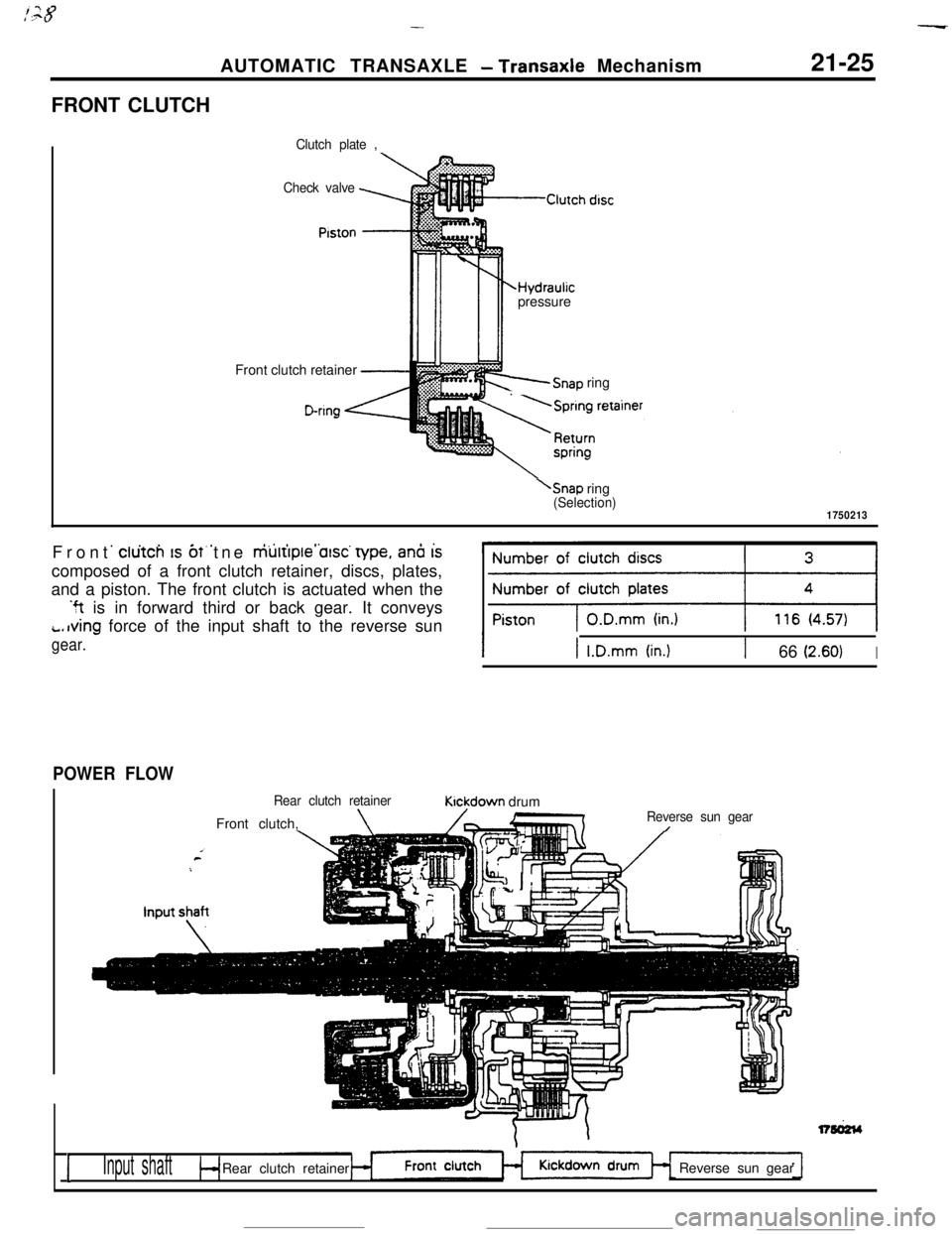
-.AUTOMATIC TRANSAXLE
- Transaxle Mechanism21-25
-FRONT CLUTCH
Clutch plate,
Check valve
Piston -Front clutch retainer
-
D-nng
XHydraulicpressure
-Snap ring
.
‘Snap ring(Selection)1750213Front
ClUtCh IS ot tne multtple alsc n/pe, ana IScomposed of a front clutch retainer, discs, plates,
and a piston. The front clutch is actuated when the‘3 is in forward third or back gear. It conveys
&..rving force of the input shaft to the reverse sun
gear.1 I.D.mm (in.)I66 (2.60)I
POWER FLOW
Rear clutch retainerFront clutch,
\
Klckdown drumReverse sun gear/
IInput shaftRear clutch retainerReverse sun gear
Page 250 of 391
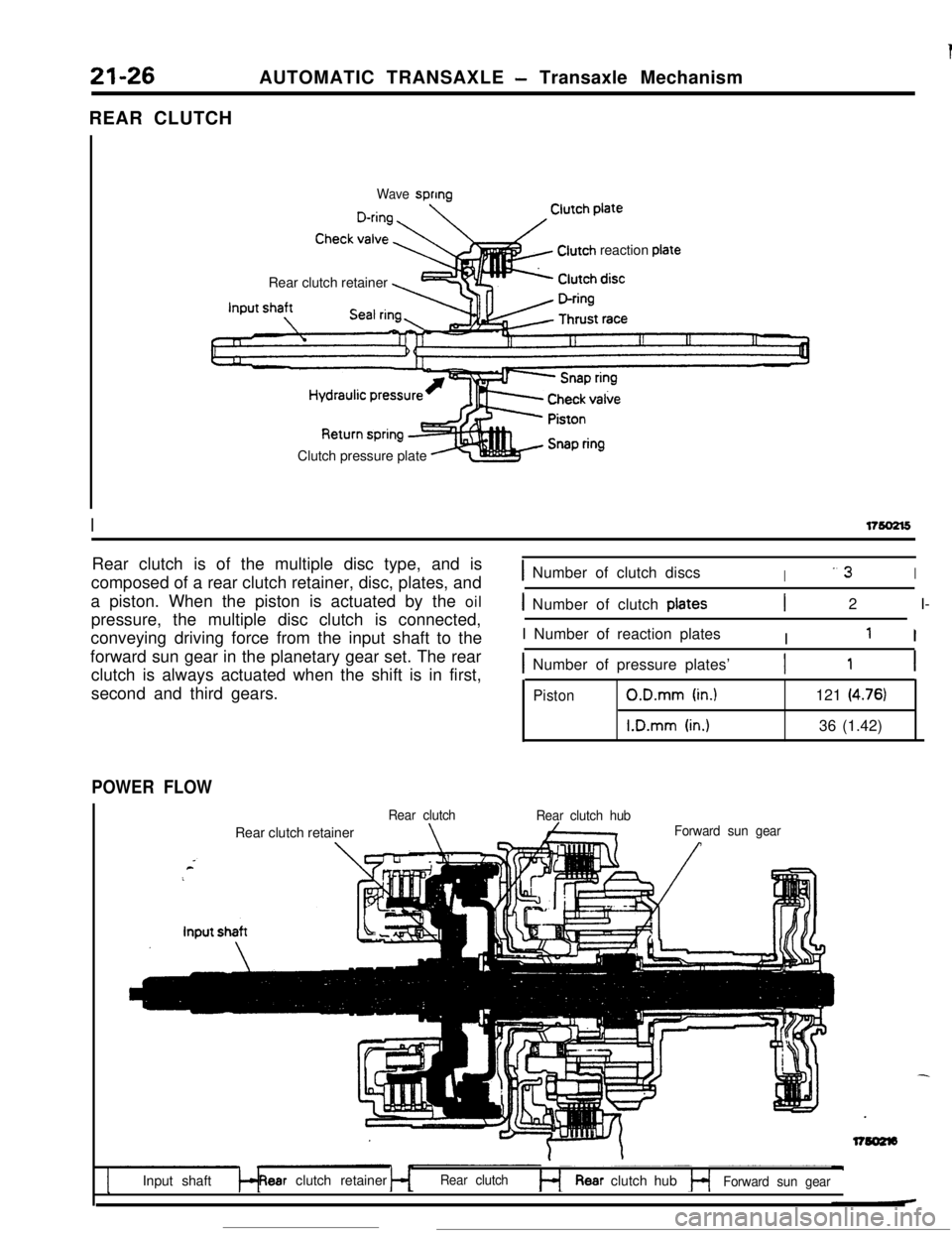
21-26AUTOMATIC TRANSAXLE - Transaxle Mechanism
REAR CLUTCH
Wave sprmgRear clutch retainer
Clutch reaction piateClutch pressure plate
I1rao2l5Rear clutch is of the multiple disc type, and is
composed of a rear clutch retainer, disc, plates, and
a piston. When the piston is actuated by the oil
pressure, the multiple disc clutch is connected,
conveying driving force from the input shaft to the
forward sun gear in the planetary gear set. The rear
clutch is always actuated when the shift is in first,
second and third gears.
INumber of clutch discsI.3I
1 Number of clutch piates1 2 I-
I Number of reaction plates
I
1 1
I Number of pressure plates’I 1 I
PistonO.D.mm (in.)121 (4.761
I.D.mm (in.)36 (1.42)
POWER FLOW
Rear clutch
Rear clutch hubRear clutch retainer
Forward sun gear,
IInput shaftRear clutch retainerRear clutchRear clutch hubForward sun gear